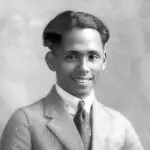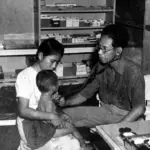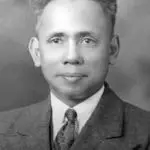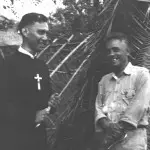Dr. Ramon Manalisay Sablan




Table of Contents
Share This
A man of opportunity
Ramon Manalisay Sablan (1902 – 1970) was the first CHamoru/Chamorro medical doctor. He is also remembered as an influential educator, politician, activist, linguist, and musician.
During his lifetime Sablan served many roles, though the most complex was that of an intercessor between the US Naval Administration and the local CHamoru people. Since Sablan received a US-sponsored medical education, but was also a CHamoru, he was often left to convince the CHamorus about the benefits of western medicine in comparison to the ancient CHamoru traditional practices and beliefs, including the supernatural forces, as well as the use of mansuruhånu (traditional healers). For some, Sablan personified:
…the potentialities of science, but also the possibilities for native compliance, collaboration, and assimilation. [Sablan] should not be viewed simply as either a victim of colonial manipulation or an agent of the navy’s colonial agenda. He might also be understood as a person who maximized the opportunities afforded to him… Sablan became empowered to assist many CHamorus in need of health care, particularly during the wartime occupation period.
Early years
Though detailed information of Sablan’s formative years remains scant, what is known is that he was born in Hagåtña to Mr. and Mrs. Pedro Sablan, and that as a young man he attended public school where he excelled in his studies.
At 18, Sablan began working as a messenger for the naval governor’s office. Shortly after he took a competitive examination and qualified for a government scholarship to attend Oklahoma Agricultural and Mechanical College at Stillwater in 1919. Sablan studied pathology and bacteriology, focusing on tuberculosis, which had been infecting and killing numerous of his fellow CHamorus.
Inspired by the socio-cultural and political happenings on the island during this time period, Sablan composed the Guam Hymn in English that same year. Lagrimas Leon Guerrero eventually translated it to CHamoru in 1974, and the song was renamed Fanohge CHamoru.
Educator and activist
Five years later, in 1924, Sablan returned to Guam where he taught and later acted as principal of a local private high school. Here he was active in organizing the Guam Teachers’ Association, calling for the establishment of a Guam Museum among other things. Sablan then became speaker of the Guam Congress’ House of Assembly. In 1925, Sablan, Atanasio Perez, and Jose Roberto made an appearance before the US House of Representatives to present an argument on behalf of US citizenship for the CHamoru people. It took 25 years before the US Congress would formally address the issue with an organic act.
Five years after the Congressional appearance, Sablan received his second scholarship from the government to attend the University of Louisville Medical School in Kentucky.
First CHamoru medical doctor
By 1937 Sablan completed his medical studies, returned to Guam, and established his own practice. Aside from seeing his own patients, he was the official physician for Pan American Airways and examiner for a US life-insurance company.
When the government ordered all US families back to the states, shortly before the onset of World War II in the Pacific, the AP Guam correspondent had to leave. Dr. Sablan took over her job, filing the news faithfully until the Japanese invading forces arrived.
Sablan’s wife and daughter also left, arriving in San Francisco on 7 December 1941. Mrs. Sablan got a job in an aircraft factory in Louisville. On Guam, Dr. Sablan moved to his family ranch as did most of the population. Of those who stayed in the villages, some were mistreated by the Japanese and fled to him for treatment.
Reportedly, Sablan administered and operated on his patients in the jungle unbeknownst to the Japanese. With the help of local nurses, Sablan, the only CHamoru physician on island, assisted the 22,000 local people during throughout the Japanese occupation.
Once the war was over and Guam was recaptured by the Americans, the US Naval Government placed Sablan in charge of the Hospital for Pulmonary Tuberculosis. When the facilities became inundated with problems, including overcrowding and mismanagement, Sablan wrote A Plea for Better Health Conditions, in which he explained the potential solutions for the worsening medical situation.
The essay was published in the Guam Recorder, a Navy-run monthly publication, in which Sablan was a columnist. While the column only ran for a few months, it was a way for Sablan to communicate with the general public, persuading more local residents to embrace the advantages of western medicine.
In 1951 Sablan and his family relocated to Long Beach, California. He and his wife, Concepcion P. Leon Guerrero, had two children: Alicia and Ramon. Sablan died in March 1970.
For further reading
Hattori, Anne Perez. Colonial Dis-ease: U.S. Navy Health Policies and the Chamorros of Guam, 1898-1941. Pacific Islands Monograph Series 19. Honolulu: University of Hawai’i Press, 2004.
I Manfåyi: Who’s Who in Chamorro History. Vol. 1. The Hale’-ta Series. Hagåtña: Political Status Education and Coordinating Commission, 1995.
Rogers, Robert. Destiny’s Landfall: A History of Guam. Honolulu: University of Hawai’i Press, 1995.
